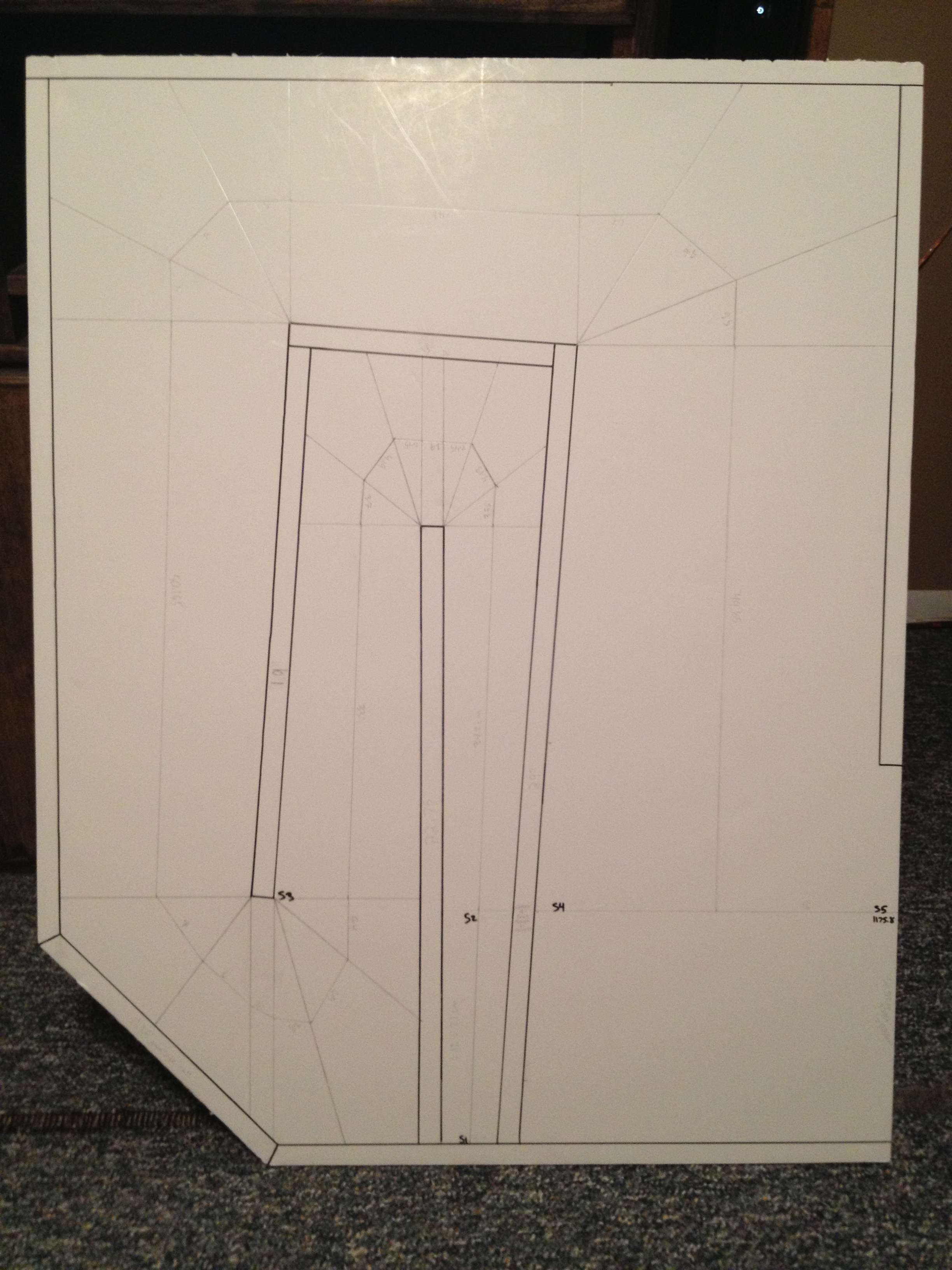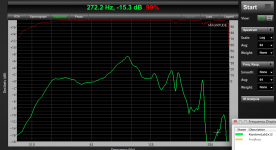There aren't many 12" tapped horns for prosound. The Lab 12 is a great driver for the price, has a strong cone for tapped horn high(ish) compression ratios, and a good amount of Xmax.
12" tapped horns can be much skinnier than 15" and 18" horns, and with the price of the Lab 12 ($165) one can use 4-8 horns and not hurt the wallet too much.
With multiple horns as opposed to one or two large 18" horns, you have more options for stacking and setup.
Figure with the 400w rms rating of the driver, huge amps aren't needed to drive the cabinets to full output.
So here is the breakdown:
$165 Eminence Lab 12 (readily available, been around forever, now two voice coil options available)
$60 per 5x5' 3/4" Baltic birch (2 sheets required)
$40 for Casters, Durtatex, terminal, screws etc
Simple folding, easy to construct. Will have handles and casters for easy transport.
38" High x 30" Deep x 15" Wide cabinet (about 10 cubic feet or 300L)
Low corner of about 35hz
15" wide cabinet maintains truck packing dimms
Group of 4 plus 2000watt amp will provide plenty of output for as little as $1600 ($1300 for 4 cabinets plus $300 for amp)
This build is with the original 6ohm driver. The new Lab12c may also work, not sure.
Lets call it "PAL12 Subwoofer" For P.A. Lab 12 Tapped Horn
DIRECTORY FOR THIS THREAD
AutoCAD drawings, 2D: (post #123)
$325 Lab 12 based PA tapped horn. ~35hz extension - Page 13 - diyAudio
3-D rendering: (post #127)
$325 Lab 12 based PA tapped horn. ~35hz extension - Page 13 - diyAudio
Construction Technique, order of panel installation: (post #129)
$325 Lab 12 based PA tapped horn. ~35hz extension - Page 13 - diyAudio
Initial measured results: (post #82)
$325 Lab 12 based PA tapped horn. ~35hz extension - Page 9 - diyAudio
Now that the sub is constructed and tested, we can post some final specs.
Operating frequency: 34Hz----120Hz +/-3db
Dimensions: 30"x38"x15"
Impedance: 4 ohms
Power handling: 400w rms, 800w program High pass 32Hz 24db/octave minimum
Weight: TBD
12" tapped horns can be much skinnier than 15" and 18" horns, and with the price of the Lab 12 ($165) one can use 4-8 horns and not hurt the wallet too much.
With multiple horns as opposed to one or two large 18" horns, you have more options for stacking and setup.
Figure with the 400w rms rating of the driver, huge amps aren't needed to drive the cabinets to full output.
So here is the breakdown:
$165 Eminence Lab 12 (readily available, been around forever, now two voice coil options available)
$60 per 5x5' 3/4" Baltic birch (2 sheets required)
$40 for Casters, Durtatex, terminal, screws etc
Simple folding, easy to construct. Will have handles and casters for easy transport.
38" High x 30" Deep x 15" Wide cabinet (about 10 cubic feet or 300L)
Low corner of about 35hz
15" wide cabinet maintains truck packing dimms
Group of 4 plus 2000watt amp will provide plenty of output for as little as $1600 ($1300 for 4 cabinets plus $300 for amp)
This build is with the original 6ohm driver. The new Lab12c may also work, not sure.
Lets call it "PAL12 Subwoofer" For P.A. Lab 12 Tapped Horn
DIRECTORY FOR THIS THREAD
AutoCAD drawings, 2D: (post #123)
$325 Lab 12 based PA tapped horn. ~35hz extension - Page 13 - diyAudio
3-D rendering: (post #127)
$325 Lab 12 based PA tapped horn. ~35hz extension - Page 13 - diyAudio
Construction Technique, order of panel installation: (post #129)
$325 Lab 12 based PA tapped horn. ~35hz extension - Page 13 - diyAudio
Initial measured results: (post #82)
$325 Lab 12 based PA tapped horn. ~35hz extension - Page 9 - diyAudio
Now that the sub is constructed and tested, we can post some final specs.
Operating frequency: 34Hz----120Hz +/-3db
Dimensions: 30"x38"x15"
Impedance: 4 ohms
Power handling: 400w rms, 800w program High pass 32Hz 24db/octave minimum
Weight: TBD
Last edited:
From the first post it appears that you already have done the sim and the fold. You may have opted for a compression of about 2 1/2 to 3. This is very exciting as it will be a viable, cheaper and easier to transport horn.
In the Collaborative..... thread, the possibility of a PA TH with the LAB 12 driver was dismissed.
So you've got something really up your sleave!!!
In the Collaborative..... thread, the possibility of a PA TH with the LAB 12 driver was dismissed.
So you've got something really up your sleave!!!
Here is the input screen...
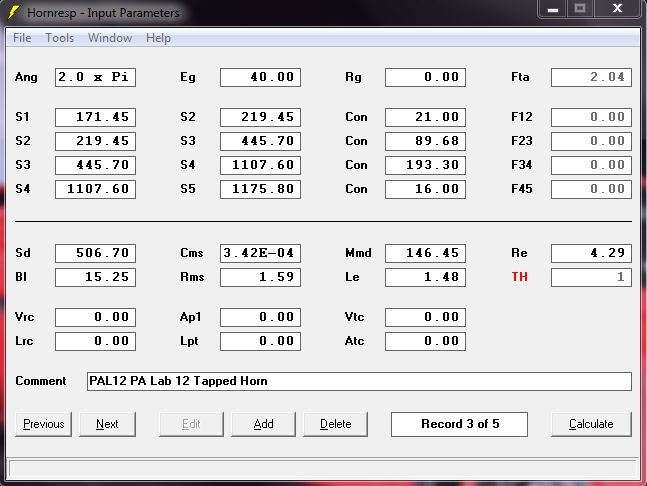
SPL at about 400 watts....i notice the large dip in the response. who knows if that will actually be there on the test cabinet; we will find out! (i know people say hornresp exaggerates the peaks and dips)

and it should be right around xmax at 400 watts or so
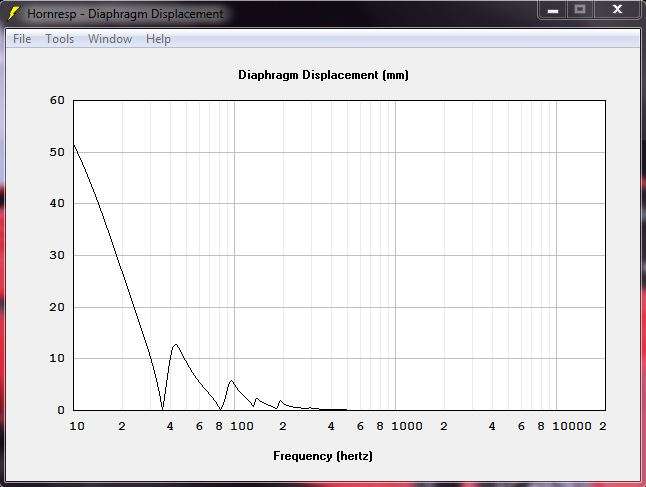

SPL at about 400 watts....i notice the large dip in the response. who knows if that will actually be there on the test cabinet; we will find out! (i know people say hornresp exaggerates the peaks and dips)

and it should be right around xmax at 400 watts or so

The Eminence Lab 12 for $165...
Eminence LAB 12 Professional 12" Subwoofer Speaker 290-570
The Heavy duty casters for $13.5 each
Penn-Elcom W8975 4" Fixed Caster w/Blue Wheel 330 lb. 262-274
Dayton Steel bar corner handles for easy transport, $9 each
Dayton Audio MH110 Right Angle Steel Bar Handle 262-820
Terminal Dish $4
Penn-Elcom D0604Z Dish Two Neutrik D Zinc 3-1/2" x 5-1/8" 262-332
$213 plus wood and screws / paint or coating for each cabinet....
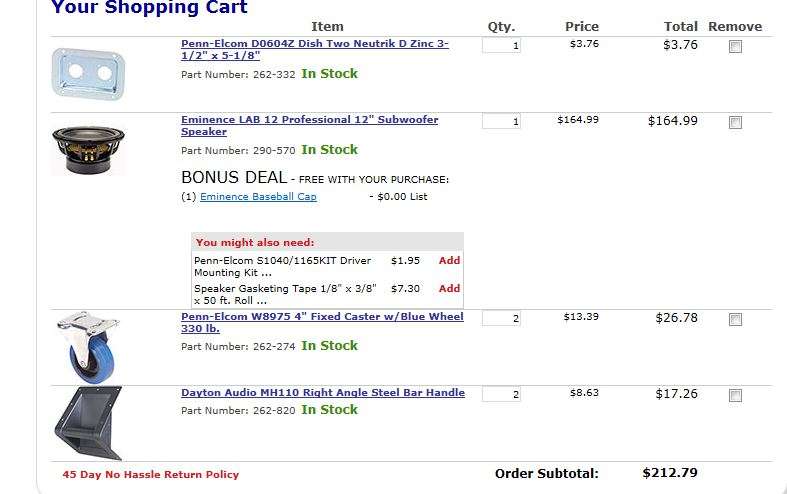
Eminence LAB 12 Professional 12" Subwoofer Speaker 290-570
The Heavy duty casters for $13.5 each
Penn-Elcom W8975 4" Fixed Caster w/Blue Wheel 330 lb. 262-274
Dayton Steel bar corner handles for easy transport, $9 each
Dayton Audio MH110 Right Angle Steel Bar Handle 262-820
Terminal Dish $4
Penn-Elcom D0604Z Dish Two Neutrik D Zinc 3-1/2" x 5-1/8" 262-332
$213 plus wood and screws / paint or coating for each cabinet....

I originally simmed 4 parallel speakers and the response appeared to dig a little deeper. Now with one it appears to be a 40hz horn. Hmm.....but path length is 320cm sooooo
Compression ratio is 2.31 : 1.
Closer to 35 Hz as the title suggests?
I am scanning through the long "Collaborative....." thread to look for the relevant posts but with no success as yet.
I originally simmed 4 parallel speakers and the response appeared to dig a little deeper. Now with one it appears to be a 40hz horn. Hmm.....but path length is 320cm sooooo
Compression ratio is 2.31 : 1.
It's usually the case when modeling up multiple horns. 40Hz for one ain't too shabby.
Planning to account for or compensate for the air volume of the cone and baffle cutout?
On this one no, because 1. The lab 12 has a relatively flat and small cone, and 2. It is pretty stiff, so I was not going to use cone correction on this.
Also, the driver is firing against a flat panel, and the entire thing is firing into the throat; unlinke some others where half the driver fires into the throat and the other half is firing into the horn path.
Is this the correct approach? I'm not sure.
By looking at some Danley horns CAD drawings, where the drivers are firing into the throat only, against a flat panel, he doesn't seem to use the \_/ cone correction there.
It's usually the case when modeling up multiple horns. 40Hz for one ain't too shabby.
I thought in modeling, yes. In reality, no.
Unless grouped together where the Frontal Area becomes acoustically large?
If we are talking about arraying them, 16+ horns (20feet wide) then maybe.
But still, if this horn does have a peak around 38-40hz, it may actually sound louder than one which is flat and rolls off gradually.
I will most likely just pick up a sheet of MDF (4x8...hoping the cabinet can be cut from a full 4x8 sheet, if it can my supplier stocks 4x8 3/4" Baltic birch, which will bring the cost of the cabinet down even more) and build the test cabinet in the next week or two.
I have the minidsp umik for measurement, but I heard there were sensitivity cal issues. So the 1w testing might not be accurate, but I should have an accurate frequency response curve.
Closer to 35 Hz as the title suggests?
I am scanning through the long "Collaborative....." thread to look for the relevant posts but with no success as yet.
Yes right around 35hz was where the peak was. The path length divided by 3 suggests a 35ish Hz low corner as well. So we shall see when I test it. 36Hz = 9.5555m / 3 = 3.1852m or 318.52cm.
The 320cm path length is pretty close to that. And I verified the path length by measuring on the actual-sized layout drawing.
Changing the inductance does flatten the dip, but in practice I'm not so sure (for pro sound) that adding an Inductor will really be benifical.
Last edited:
Since the excursion minima should be around 36 Hz no problem to EQ it flat to a bit below that.Yes right around 35hz was where the peak was. The path length divided by 3 suggests a 35ish Hz low corner as well. So we shall see when I test it. 36Hz = 9.5555m / 3 = 3.1852m or 318.52cm.
The 320cm path length is pretty close to that.
The fold pattern would benefit from a Keystone exit, loosing a bit of the "saddle" in the response.
The upper peak will probably still be there, will be interesting to see how your TH turns out.
I'd expect if you get the mouth shape right it will be very close to the same response as the Keystone 2xLab 12", just 3 dB down in sensitivity (6 dB less output) since it uses one cone instead of two.
Good luck!
Attachments
Yea more Pro sound people !

I would allocate 800-1000W per cabinet, what do you usually run Art?....
Wait what's that about two voice coils available? Are you talking about the Lab12c which is 4ohms or is there a DVC version I've missed?
I like to have a peak at the bottom end to compensate for the falling hearing sensitivity.
I need to go back and reread the Keystone threads. Did anyone have a theory as to why the mouth shape is beneficial? It seams that the keystone would lend itself best to dual driver THs due to symmetrical shape.
Best of luck in your build!
-Matt
I would allocate 800-1000W per cabinet, what do you usually run Art?....
Wait what's that about two voice coils available? Are you talking about the Lab12c which is 4ohms or is there a DVC version I've missed?
I like to have a peak at the bottom end to compensate for the falling hearing sensitivity.
I need to go back and reread the Keystone threads. Did anyone have a theory as to why the mouth shape is beneficial? It seams that the keystone would lend itself best to dual driver THs due to symmetrical shape.
Best of luck in your build!
-Matt
Correct, I was talking about the regular Lab 12 and the Lab 12c, in another thread, which is what I meant by two versions available.
There is no DVC option for the Lab 12.
The Lab 12 only has a 2.5" Voice Coil, and cooling of the coil isn't the greatest, which is why I'd want to keep it around 500 watts rms Max for this design.
The cost ($325, and if I can get it all out of one 4x8 sheet, even less than that, possibly $290 per cabinet) should allow you to just build multiples if you need more output.
If one needs 3kw cabinets, this isn't the cabinet for you!
Edit: didn't think I mentioned the two different VC's in this thread. Guess I did. Sorry for the confusion.
The sim I posted is for the Lab 12. (That I currently own)
I will run a sim for the Lab 12 c and see if its any different.
There is no DVC option for the Lab 12.
The Lab 12 only has a 2.5" Voice Coil, and cooling of the coil isn't the greatest, which is why I'd want to keep it around 500 watts rms Max for this design.
The cost ($325, and if I can get it all out of one 4x8 sheet, even less than that, possibly $290 per cabinet) should allow you to just build multiples if you need more output.
If one needs 3kw cabinets, this isn't the cabinet for you!
Edit: didn't think I mentioned the two different VC's in this thread. Guess I did. Sorry for the confusion.
The sim I posted is for the Lab 12. (That I currently own)
I will run a sim for the Lab 12 c and see if its any different.
Last edited:
mattlong8; I would allocate 800-1000W per cabinet said:Matt,
In a TH with a simple up and down fold pattern like mRgSr's PAL12, the Keystone exit shape allows a compromise between a “too large” and “too small” opening.
Too large an opening provides more upper response with less low end, too small makes for a lower LF corner but less upper response.
By adjusting the area and shape, one can optimize the response of the cabinet for the desired frequency response.
IIRC I tested the dual lab 12 Keystone at around 400 watts of sine wave per driver and distortion and excursion were OK.
Using the Lab 12s ported I powered them with about 500 watts each, in a FLH I use about 1200 watts per cone.
They sounded fine with that much peak power in the Keystone with dynamic program material.
For small club use, a bottom "loudness contour" peak can be useful, since there is often too much "stage gack" around 100 Hz to begin with.
My preference for outdoors and larger venues is a rising upper response equalized flat, as most musical genre needs more upper (around 100 Hz) peak headroom than LF.
Art
- Home
- Loudspeakers
- Subwoofers
- $325 Lab 12 based PA tapped horn ~ 35Hz extension

